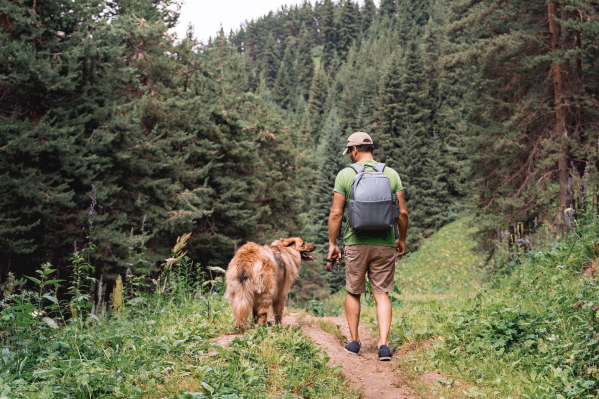Warmer weather means more chances for you and your pup to get outside and enjoy all that nature has to offer. One popular activity among outdoorsy pet parents is hiking. Whether it’s a relatively easy trek through a local park or a more strenuous climb in the mountains, hiking with your dog can be a great way for you both to get some exercise.
Like all trips into the wilderness, however, it’s important to be prepared for the excursion and to be aware of potential hazards and dangers for your furry friend. Here are some safety tips to keep in mind as you put on your hiking boots and head to the great outdoors with your pup.
Safety tips for hiking with your dog
Check the weather
It’s best to be prepared for the elements when you and your dog head out for a hike. If it looks like it will rain, for example, the best option is probably to postpone your excursion to another day. If it’s a nice and sunny day, it’s a good time to hit the trails, although if it’s especially warm, you should keep an eye on your dog to make sure they don’t overheat, especially if they’re a pup with a thick fur coat.
Dogs are only able to cool off via panting and through sweat glands in their paws. If the weather is extremely hot, it's worth postponing your hike. If you go out and it's warm out, make sure to bring plenty of water for both you and your pup. Even if the temps aren't super high, it's still wise to keep an eye out for signs your dog may be overheating. Symptoms include drooling, vomiting, excessive panting, dizziness, diarrhea, increased pulse, muscle tremors, and gum discoloration.
If your hike involves going by a stream or lake that is safe for your pup to swim in, that’s a great option to help them cool down as well. Just make sure there's no blue-green algae present and monitor your pup for behavior changes after swimming.
Bring the right supplies
In addition to plenty of water, it’s important to bring other supplies with you on your trip. Snacks are always a good thing to have if either of you get hungry, and if you'll be exposed to the sun for a long period of time, it's also wise to pack some pet sunscreen.
Having a first-aid kit on hand for your dog is also a good safety precaution. A well-stocked kit should have blunt scissors, tweezers, gloves, a thermometer, hydrogen peroxide, bandages, cotton swabs, saline solution, and an extra leash.
Protect your pup’s paws
It might be worth having your dog wear booties, even if their paws aren’t overly sensitive. Paw pad injuries are more likely to happen on trails with rough and uneven terrain, and booties can help protect against injury.
If your dog does hurt their paw pads (symptoms include limping or licking/gnawing of the affected area), you have your first-aid kit on hand to treat them while on the trail until you can get them to the vet. Clean the wound with the saline solution and wrap it with gauze if you can, and if they’re small enough and the trail isn’t too treacherous, consider carrying them out.
Be mindful of plants
One common cause of paw injuries comes from foxtails, which are dangerous to dogs. Foxtails are on the top of grasses that have gone to seed, and can burrow through a lot, including your pup’s paws, ears, nose, and even eyelids. If you see a patch of foxtails, veer your dog away, and when you’re done with the hike, you should give you furry friend a quick look over. If your dog gets a pink blister on their foot, starts sneezing a lot or scratching their eye a little bit after a hike, it’s worth giving them another look.
Foxtails aren’t the only plants to be mindful of when on a hike with your pup. Other plants and herbs can be toxic to dogs including aloe vera, the appropriately named dogsbane, amaryllis, and many others (you can find a longer list here).
On a related note, tall grasses and underbrush are also homes for fleas and ticks, so it’s also important to make sure your dog is on the best flea and tick medication for their individual needs before heading out.
Don’t overdo it
A hike is a great way for you and your dog to get some exercise, but too much exercise for your pup can do more harm than good. If your dog is showing signs that they’re tired—plopping down on the trail, for example, rather than bounding ahead—they may need a break. Another sign they may have overdone it is if they walk stiffly or appear to be in pain when they stand up the following day after a long trek. If this occurs, make sure they have time to recover and consider going on a shorter hike next time.
If you keep these safety tips in mind, you and your dog will have a wonderful excursion in the great outdoors. If you have any questions about hiking-related injuries or illnesses, reach out to the team at Pawp—we're here to help you and your furry friend 24/7.
